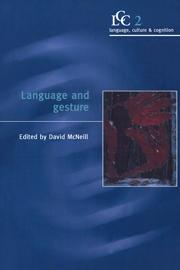Book contents
- Frontmatter
- Contents
- Acknowledgments
- Introduction
- Part 1 Gesture in action
- 1 Pointing, gesture spaces, and mental maps
- 2 Language and gesture: unity or duality?
- 3 The influence of addressee location on spatial language and representational gestures of direction
- 4 Gesture, aphasia, and interaction
- 5 Gestural interaction between the instructor and the learner in origami instruction
- 6 Gestures, knowledge, and the world
- Part 2 Gesture in thought
- Part 3 Modeling gesture performance
- Part 4 From gesture to sign
- Index
6 - Gestures, knowledge, and the world
Published online by Cambridge University Press: 07 January 2010
- Frontmatter
- Contents
- Acknowledgments
- Introduction
- Part 1 Gesture in action
- 1 Pointing, gesture spaces, and mental maps
- 2 Language and gesture: unity or duality?
- 3 The influence of addressee location on spatial language and representational gestures of direction
- 4 Gesture, aphasia, and interaction
- 5 Gestural interaction between the instructor and the learner in origami instruction
- 6 Gestures, knowledge, and the world
- Part 2 Gesture in thought
- Part 3 Modeling gesture performance
- Part 4 From gesture to sign
- Index
Summary
The formation of gestures and the fabrication of knowledge
Among the essential (but almost forgotten) insights of the Age of Enlightenment was the recognition that “human understanding” (Locke 1959 [1690]) – the formation and accumulation of common knowledge – is dependent upon the formation and accumulation of material signs: material entities that reside, however fleetingly, in the public realm where they may be reused and thereby shared; representations that embody a world that may be jointly acted and reflected upon; artifacts that, while products of minds, are nevertheless external to them, providing tools not only for the mind, but also for labor and human self-creation; socially shared cognitive tools that evolve over time as humanity's mind evolves through relying on and refining them.
With this proposition, anti-Cartesian philosophers such as Condillac for the first time directed attention to the importance of symbol systems (or media) for human cognition, self-creation, and society. Condillac in particular recognized the inherently social character of the human mind, and he suggested that signs and insights originate in social practice. He wrote:
[The] history of communication will show the various circumstances under which signs have been formed. It will show us the true meanings of signs and … leave no doubt about the origin of our ideas.
(Condillac 1746: 61)Condillac called signs “sensations transformées,” transformed sensations, by which he meant the entire complex of affect, desire, sensory perception, and motor action that makes up what nowadays we might call ‘embodied experience’.
Information
- Type
- Chapter
- Information
- Language and Gesture , pp. 118 - 138Publisher: Cambridge University PressPrint publication year: 2000
Accessibility standard: Unknown
Why this information is here
This section outlines the accessibility features of this content - including support for screen readers, full keyboard navigation and high-contrast display options. This may not be relevant for you.Accessibility Information
- 75
- Cited by
